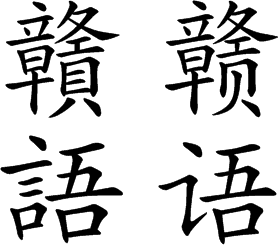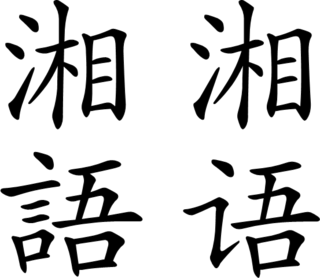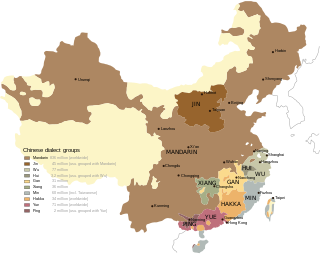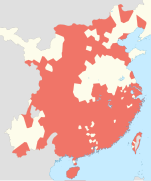
Chinese is a group of languages spoken natively by the ethnic Han Chinese majority and many minority ethnic groups in China. Approximately 1.35 billion people, or around 16% of the global population, speak a variety of Chinese as their first language.

Mandarin is a group of Chinese language dialects that are natively spoken across most of northern and southwestern China. The group includes the Beijing dialect, the basis of the phonology of Standard Chinese, the official language of China. Because Mandarin originated in North China and most Mandarin dialects are found in the north, the group is sometimes referred to as Northern Chinese. Many varieties of Mandarin, such as those of the Southwest and the Lower Yangtze, are not mutually intelligible with the standard language. Nevertheless, Mandarin as a group is often placed first in lists of languages by number of native speakers.

Standard Chinese is a modern standard form of Mandarin Chinese that was first codified during the republican era (1912‒1949). It is designated as the official language of mainland China and a major language in the United Nations, Singapore, and Taiwan. It is largely based on the Beijing dialect. Standard Chinese is a pluricentric language with local standards in mainland China, Taiwan and Singapore that mainly differ in their lexicon. Hong Kong written Chinese, used for formal written communication in Hong Kong and Macau, is a form of Standard Chinese that is read aloud with the Cantonese reading of characters.

Hakka forms a language group of varieties of Chinese, spoken natively by the Hakka people in parts of Southern China and some diaspora areas of Taiwan, Southeast Asia and in overseas Chinese communities around the world.

Yue is a branch of the Sinitic languages primarily spoken in Southern China, particularly in the provinces of Guangdong and Guangxi.

Min is a broad group of Sinitic languages with about 70 million native speakers. These languages are spoken in Fujian province as well as by the descendants of Min-speaking colonists on the Leizhou Peninsula and Hainan and by the assimilated natives of Chaoshan, parts of Zhongshan, three counties in southern Wenzhou, the Zhoushan archipelago, Taiwan and scattered in pockets or sporadically across Hong Kong, Macau, and several countries in Southeast Asia, particularly Singapore, Malaysia, the Philippines, Indonesia, Thailand, Myanmar, Cambodia, Vietnam, Brunei. The name is derived from the Min River in Fujian, which is also the abbreviated name of Fujian Province. Min varieties are not mutually intelligible with one another nor with any other variety of Chinese.

Wu is a major group of Sinitic languages spoken primarily in Shanghai, Zhejiang Province, and the part of Jiangsu Province south of the Yangtze River, which makes up the cultural region of Wu. Speakers of various Wu languages sometimes labelled their mother tongue as Shanghainese when introduced to foreigners. The Suzhou dialect was the prestige dialect of Wu as of the 19th century, but had been replaced in status by Shanghainese by the turn of the 20th century. The languages of Northern Wu are mutually intelligible with each other, while those of Southern Wu are not.
The Shanghainese language, also known as the Shanghai dialect, or Hu language, is a variety of Wu Chinese spoken in the central districts of the city of Shanghai and its surrounding areas. It is classified as part of the Sino-Tibetan language family. Shanghainese, like the rest of the Wu language group, is mutually unintelligible with other varieties of Chinese, such as Mandarin.

Gan,Gann or Kan is a group of Sinitic languages spoken natively by many people in the Jiangxi province of China, as well as significant populations in surrounding regions such as Hunan, Hubei, Anhui, and Fujian. Gan is a member of the Sinitic languages of the Sino-Tibetan language family, and Hakka is the closest Chinese variety to Gan in terms of phonetics.

Xiang or Hsiang, also known as Hunanese, is a group of linguistically similar and historically related Sinitic languages, spoken mainly in Hunan province but also in northern Guangxi and parts of neighboring Guizhou, Guangdong, Sichuan, Jiangxi and Hubei provinces. Scholars divided Xiang into five subgroups, Chang-Yi, Lou-Shao, Hengzhou, Chen-Xu and Yong-Quan. Among those, Lou-shao, also known as Old Xiang, still exhibits the three-way distinction of Middle Chinese obstruents, preserving the voiced stops, fricatives, and affricates. Xiang has also been heavily influenced by Mandarin, which adjoins three of the four sides of the Xiang-speaking territory, and Gan in Jiangxi Province, from where a large population immigrated to Hunan during the Ming dynasty.

Pinghua refers to various Sinitic language varieties spoken mainly in parts of Guangxi, with some speakers in Hunan. Pinghua is a trade language in some areas of Guangxi, spoken as a second language by speakers of Zhuang languages. Some speakers are officially classified as Zhuang, and many are genetically distinct from most other Han Chinese. The northern subgroup is centered on Guilin and the southern subgroup around Nanning. The Southern dialect has several notable features such as having four distinct checked tones, and using various loanwords from the Zhuang languages, such as the final particle wei for imperative sentences.
General Chinese is a diaphonemic orthography invented by Yuen Ren Chao to represent the pronunciations of all major varieties of Chinese simultaneously. It is "the most complete genuine Chinese diasystem yet published". It can also be used for the Korean, Japanese, and Vietnamese pronunciations of Chinese characters, and challenges the claim that Chinese characters are required for interdialectal communication in written Chinese.

The Sinitic languages, often synonymous with the Chinese languages, are a group of East Asian analytic languages that constitute a major branch of the Sino-Tibetan language family. It is frequently proposed that there is a primary split between the Sinitic languages and the rest of the family. This view is rejected by a number of researchers but has found phylogenetic support among others. The Macro-Bai languages, whose classification is difficult, may be an offshoot of Old Chinese and thus Sinitic; otherwise Sinitic is defined only by the many varieties of Chinese unified by a shared historical background, and usage of the term "Sinitic" may reflect the linguistic view that Chinese constitutes a family of distinct languages, rather than variants of a single language.
The Hangzhou dialect is spoken in the city of Hangzhou, China and its immediate suburbs, but excluding areas further away from Hangzhou such as Xiāoshān (蕭山) and Yúháng (余杭). Its number of speakers has been estimated to be about 1.2 to 1.5 million. It is a dialect of Wu, one of the Chinese varieties.
Hashimoto Mantarō was a Japanese sinologist and linguist who is best known for advocating research on language geography, linguistic typology, and how different areal features in the varieties of Chinese reflect contact with other language families.

Lower Yangtze Mandarin is one of the most divergent and least mutually-intelligible of the Mandarin languages, as it neighbours the Wu, Hui, and Gan groups of Sinitic languages. It is also known as Jiang–Huai Mandarin, named after the Yangtze (Jiang) and Huai Rivers. Lower Yangtze is distinguished from most other Mandarin varieties by the retention of a final glottal stop in words that ended in a stop consonant in Middle Chinese.
The Nanjing dialect, also known as Nankingese, Nanjingese and Nanjing Mandarin, is the prestige dialect of Mandarin spoken in the urban area of Nanjing, China. It is part of the Jianghuai group of Chinese varieties.
Proto-Min is a comparative reconstruction of the common ancestor of the Min group of varieties of Chinese. Min varieties developed in the relative isolation of the Chinese province of Fujian and eastern Guangdong, and have since spread to Taiwan, Southeast Asia, and other parts of the world. They contain reflexes of distinctions not found in Middle Chinese or most other modern varieties, and thus provide additional data for the reconstruction of Old Chinese.
Northern Wu, or Taihu Wu, is the largest subbranch of Wu Chinese, and is spoken in Shanghai, southern Jiangsu, and northern Zhejiang. These languages are noted for their extremely high number of vowels, even compared to some Germanic languages, and highly complex tone sandhi. This article will use Wugniu and IPA for transcription.

























